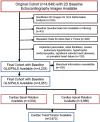Association of Female Menopause With Atrioventricular Mechanics and Outcomes
- PMID: 35528841
- PMCID: PMC9068967
- DOI: 10.3389/fcvm.2022.804336
Association of Female Menopause With Atrioventricular Mechanics and Outcomes
Abstract
Background: Despite known sex differences in cardiac structure and function, little is known about how menopause and estrogen associate with atrioventricular mechanics and outcomes.
Objective: To study how, sex differences, loss of estrogen in menopause and duration of menopause, relate to atrioventricular mechanics and outcomes.
Methods: Among 4051 asymptomatic adults (49.8 ± 10.8 years, 35%women), left ventricular (LV) and left atrial (LA) mechanics were assessed using speckle-tracking.
Results: Post-menopausal (vs. pre-menopausal) women had similar LV ejection fraction but reduced GLS, reduced PALS, increased LA stiffness, higher LV sphericity and LV torsion (all p < 0.001). Multivariable analysis showed menopause to be associated with greater LV sphericity (0.02, 95%CI 0.01, 0.03), higher indexed LV mass (LVMi), lower mitral e', lower LV GLS (0.37, 95%CI 0.04-0.70), higher LV torsion, larger LA volume, worse PALS (∼2.4-fold) and greater LA stiffness (0.028, 95%CI 0.01-0.05). Increasing years of menopause was associated with further reduction in GLS, markedly worse LA mechanics despite greater LV sphericity and higher torsion. Lower estradiol levels correlated with more impaired LV diastolic function, impaired LV GLS, greater LA stiffness, and increased LV sphericity and LV torsion (all p < 0.05). Approximately 5.5% (37/669) of post-menopausal women incident HF over 2.9 years of follow-up. Greater LV sphericity [adjusted hazard ratio (aHR) 1.04, 95%CI 1.00-1.07], impaired GLS (aHR 0.87, 95%CI 0.78-0.97), reduced peak left atrial longitudinal strain (PALS, aHR 0.94, 95%CI 0.90-0.99) and higher LA stiffness (aHR 10.5, 95%CI 1.69-64.6) were independently associated with the primary outcome of HF hospitalizations in post-menopause. Both PALS < 23% (aHR:1.32, 95%CI 1.01-3.49) and GLS < 16% (aHR:5.80, 95%CI 1.79-18.8) remained prognostic for the incidence of HF in post-menopausal women in dichotomous analyses, even after adjusting for confounders. Results were consistent with composite outcomes of HF hospitalizations and 1-year all-cause mortality as well.
Conclusion: Menopause was associated with greater LV/LA remodeling and reduced LV longitudinal and LA function in women. The cardiac functional deficit with menopause and lower estradiol levels, along with their independent prognostic value post-menopause, may elucidate sex differences in heart failure further.
Keywords: echocardiography; estrogen; heart failure; left atrial strain; menopause; remodeling; women.
Copyright © 2022 Sung, Chandramouli, Lo, Tsai, Lai, Hsiao, Tsai, Yun, Hung, Kuo, Lin, Hou, Chen, Su, Hung, Bulwer, Yeh and Lam.
Conflict of interest statement
The authors declare that the research was conducted in the absence of any commercial or financial relationships that could be construed as a potential conflict of interest.
Figures




References
-
- Solomon SD, McMurray JJV, Anand IS, Ge J, Lam CSP, Maggioni AP, et al. Angiotensin-neprilysin inhibition in heart failure with preserved ejection fraction. N Engl J Med. (2019) 381:1609–20. - PubMed
-
- Muka T, Oliver-Williams C, Kunutsor S, Laven JS, Fauser BC, Chowdhury R, et al. Association of age at onset of menopause and time since onset of menopause with cardiovascular outcomes, intermediate vascular traits, and all-cause mortality: a systematic review and meta-analysis. JAMA Cardiol. (2016) 1:767–76. 10.1001/jamacardio.2016.2415 - DOI - PubMed
LinkOut - more resources
Full Text Sources
Research Materials
Miscellaneous

